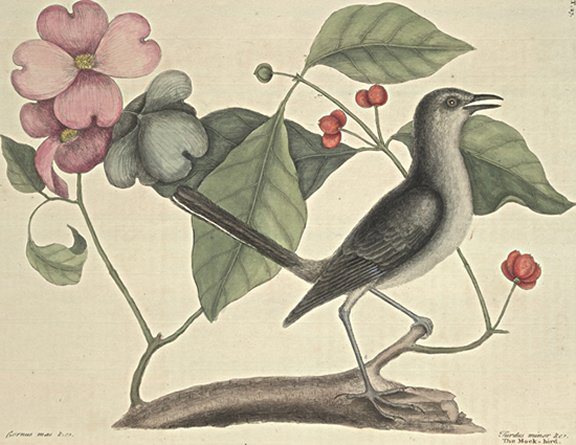Plate Number: I 27Turdus Minor Cinereo-Albus Non Maculatus: The Mock-Bird This Bird is about as big or rather less than a Blackbird, and of a slenderer Make. The Bill is black; the Iris of the Eye of a brownish yellow; the Back and Tail dark-brown; the Breast and Belly light-gray; the Wings brown, except that the upper part of the Quill-feathers have their exterior Vanes white; and some of the small feathers, near the shoulder of the Wing, are verged with white. The Cocks and Hens are so like that they are not easily distinguished by the colour of their feathers. Herandez justly calls it the Queen of all singing Birds. The Indians, by way of eminence or admiration, call it Cencontlatolly, or four hundred tongues; and we call it (tho' not by so elevated a name, yet very properly) the Mock-bird, from its wonderful mocking and imitating the notes of all Birds, from the Humming Bird to the Eagle. From March till August it sings incessantly day and night with the greatest variety of Notes; and, to compleat his compositions, borrows from the whole Choir, and repeats tho them their own Tunes with such artful Melody, that it is equally pleasing and surprising. They may be said not only to sing but dance, by grandually raising themselves from the place where they stand, with their Wings extended, and falling with their Head down to the same place; then turning round, with their Wings continuing spread, have many pretty antic Gesticulations with their Melody. They are familiar and sociable Birds, usually pearching on the tops of Chimneys or Trees, amongst, the Inhabitans, who are diverted with their tuneful Airs most part of the Summer. Their food are Haws, Berries and Insects. In winter, when there is less variety and plenty, they will eat the berries of Dogwood. Cornus mas Virginiana flosculis in corymbo digestis perianthio titrapetalo albo: The Dogwood TreeThis is a small Tree, the Trunc being seldom above eight or ten Inches thick. The Leaves resemble our common Dogwood, but are fairer and larger, standing opposite to each other on foot-stalks of about an Inch long, from among which branch forth many Flowers in the fallowing manner. In the beginning of March the blossoms break forth; and though perfectly formed and wide open, are not so wide as a Six-pence; increasing gradually to the breadth of a Man's hand, being not at their full bigness till about six Weeks after they began to open. Each Flower consists of four greenish white Leaves, every leaf having a deep indenture at the end. From the bottom of the Flower rises a tuft of yellow Stamina; every one of which opens a-top into four small Leaves or Petals: The Wood is white, has a close grain, and very hard like that of Boxe. The Flowers are succeded by clusters of Berries, having from two to six in a cluster, closely joyned, and set on food-stalks an inch long. These berries are red, of an oval form, and of the size of large Haws, containing a hard stone. As the Flowers are a great Ornament to the Woods in Summer, so are the Berries in Winter, they remaining full on the Trees usually till the approach of Spring: and being very bitter are little coveted by Birds, except in time of Dearth. I have observed Mock-birds and other kinds of Thrushes to feed on them. In Virginia I found one of these Dogwood trees with Flowers of a rose-colour, which was luckily blown down, and many of its Branches had taken Root, which I transplanted into a Garden. That with the white flower Mr. Fairchild has in his Garden. |